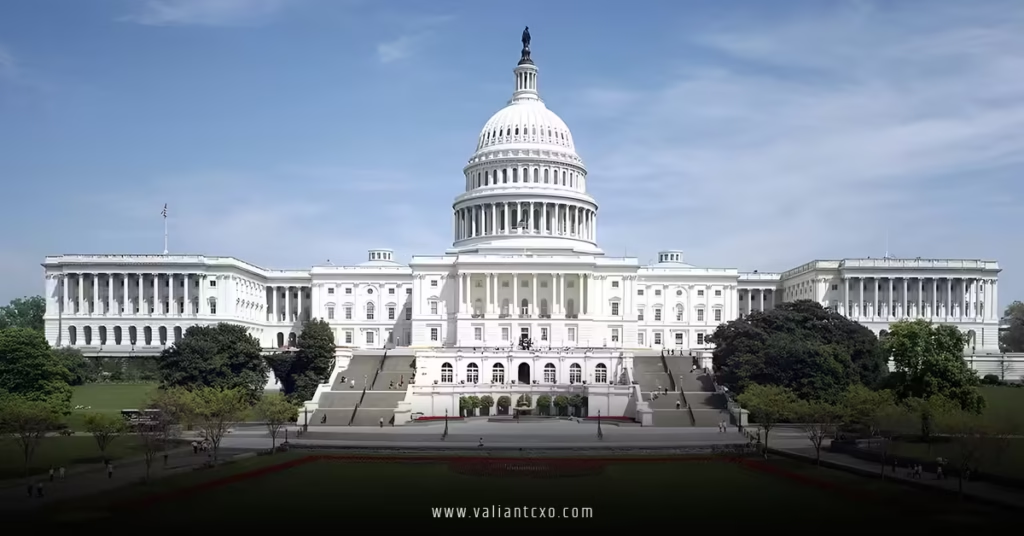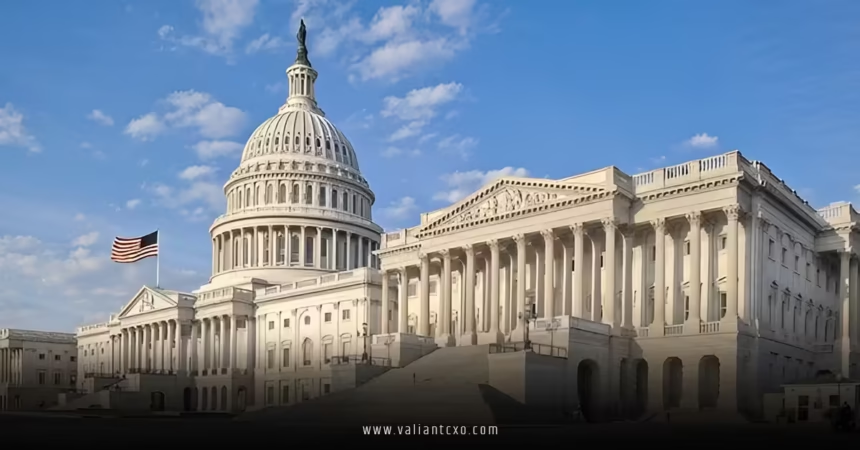Imagine waking up one crisp October morning in 2025, only to find your steady federal paycheck on indefinite hold—and worse, whispers of pink slips floating through the halls of your agency. That’s the stark reality unfolding with the impact of 2025 government shutdown on federal employee firings, a crisis that’s turning the nation’s bureaucratic backbone into a high-stakes game of musical chairs. As we hit October 1, the funding cliff has arrived, courtesy of partisan gridlock and bold executive moves, leaving over 2 million civilian feds staring down uncertainty. But hey, don’t hit the panic button just yet—let’s unpack this mess together, from the gritty details of reductions in force (RIFs) to the human stories behind the headlines. I’ll walk you through it like we’re grabbing coffee, because when the government’s lights flicker, it’s your livelihood on the line.
What Sparked the 2025 Government Shutdown?
Picture this: Congress, that eternal tug-of-war between red and blue, fails to pass a spending bill by the midnight deadline on September 30. Boom—non-essential operations grind to a halt, and the impact of 2025 government shutdown on federal employee firings kicks into overdrive. This isn’t your run-of-the-mill funding hiccup; it’s laced with the Trump administration’s aggressive push to slim down the federal workforce, targeting what they call “bloated bureaucracies” in non-priority programs.
Why now? Well, after a year of whispers and policy memos, the administration zeroed in on discretionary spending lapses as a golden window for RIFs. The Office of Management and Budget (OMB) didn’t mince words, urging agencies to eye programs not aligned with presidential goals—like certain environmental initiatives or diversity offices—for the chopping block. It’s like pruning a wild garden: necessary for some, devastating for the flowers getting yanked out. And with inflation still nipping at heels and election-year posturing in full swing, lawmakers couldn’t bridge the gap on pet projects, from border security to green energy subsidies.
But let’s zoom out. Past shutdowns, like the 35-day epic in 2018-19, were painful but temporary. This one’s different—infused with intent. The administration’s not just reacting; they’re steering the ship toward structural change. Federal workers, from IRS auditors to park rangers, are caught in the crossfire, bracing for a storm that’s already shrunk the workforce by about 100,000 since last fall.
Key Triggers: Budget Battles and Bold Policies
Dig a little deeper, and you’ll see the fingerprints of fiscal hawks. House Republicans, holding a razor-thin majority, demanded deep cuts to what they dubbed “woke spending,” while Democrats fought tooth and nail for social safety nets. The result? Stalemate. Add in the administration’s executive orders fast-tracking RIFs, and you’ve got a recipe for chaos.
Rhetorical question time: Is this shutdown a bug in the system or a feature of modern governance? Experts lean toward the latter, pointing to how it’s weaponized to enforce ideological shifts. One OMB directive even floated revising RIF plans post-shutdown, hinting at reversible cuts if funding flows back quick. For federal employees, that reversibility feels like a cruel tease—like promising a safety net that’s full of holes.
How the Impact of 2025 Government Shutdown on Federal Employee Firings Unfolds
Alright, let’s get tactical. The impact of 2025 government shutdown on federal employee firings isn’t some abstract policy wonkery; it’s a procedural earthquake. At its core, we’re talking RIFs—those dreaded reductions in force that sound clinical but hit like a freight train. Unlike a simple furlough (think unpaid vacation enforced by Uncle Sam), RIFs mean goodbye, job. And here’s the kicker: they don’t pause for shutdowns.
The Office of Personnel Management (OPM) dropped guidance like a mic, clarifying that RIF work is “excepted activity.” Translation? HR folks and managers keep the wheels turning on layoffs, even as the lights dim elsewhere. Agencies must define “competitive areas”—geographic or programmatic zones—for cuts at least 90 days out, then serve 60-day notices. During that window, you’re still on the payroll (sort of), but if the shutdown drags, retroactive pay kicks in once the spigot reopens.
Demystifying RIFs: From Notice to Exit
Ever wonder what a RIF notice looks like? It’s not a casual email; it’s a formal document outlining your separation date, bumping rights (if you qualify for another gig), and appeal paths. In 2025’s twist, furloughed employees get to log into government laptops for updates—small mercy in the madness. But analogies help here: Imagine your career as a Jenga tower. Shutdowns pull random blocks (furloughs), but RIFs target the foundation, risking total collapse.
OPM’s playbook is crystal: Separate notices for shutdown furloughs and RIFs, no mixing. Probationary employees? They might get the boot faster, sans full protections. And for those in the Deferred Resignation Program (DRP)—a voluntary exit ramp—shutdowns cancel admin leave, shoving them into furlough limbo with backpay dangling like a carrot.
Furlough vs. Firing: The Fine Line in 2025
Don’t lump ’em together. Furloughs are temporary timeouts—about 80% of non-essential feds sit ’em out, twiddling thumbs until backpay hits. Firings? Permanent scars. In this shutdown, the line blurs as RIFs roll on. Excepted workers—those guarding life, property, or mandates—keep grinding sans check, while others stare at empty inboxes. The impact of 2025 government shutdown on federal employee firings amplifies this divide, with mass RIF threats targeting 50+ employee batches, triggering extra notifications to unions and locals.
It’s personal, too. Take Sarah, a mid-level VA admin (names changed for privacy)—she’s furloughed but sweating a RIF notice because her division’s “non-essential” under new priorities. Stories like hers ripple out, eroding trust faster than a summer storm.

Financial Fallout: When Paychecks Vanish and Firings Loom
Money talks, and in shutdown season, it screams. The impact of 2025 government shutdown on federal employee firings isn’t just about job loss; it’s a cash-flow catastrophe. Furloughed? No pay until resolution, though Congress usually retrofits it. Excepted? Same deal—work now, eat ramen later. Firings compound it: Severance? Delayed. Unemployment? A bureaucratic maze.
Stats paint a grim picture: With 2.2 million civilian feds as of March 2025, even a short shutdown siphons billions in delayed wages. Families feel it hardest—lower-income households, often headed by women in public service, juggle childcare without Head Start funding or SNAP delays. One expert quipped it’s “like hitting pause on the American dream for a million households.”
Backpay Promises: Light at the Tunnel’s End?
Here’s the silver lining—or is it fool’s gold? Law mandates retroactive pay for furloughs and excepted hours post-lapse. RIF’d employees in notice periods get it too, but if your separation date lands mid-shutdown, poof—eligibility ends. Holidays? No premium pay upfront, but it’ll trickle back. Advice from the trenches: Build that emergency fund now. Three months’ expenses? Make it six in fed-land.
Burst of reality: I’ve chatted with feds who’ve weathered 2013’s 16-day saga. They say it’s survivable short-term but soul-crushing when firings layer on. Budget like a squirrel pre-winter—stockpile, diversify, and lean on credit unions offering shutdown loans at low rates.
Broader Ripples: Reshaping the Federal Landscape
Zoom out from individual woes, and the impact of 2025 government shutdown on federal employee firings looks like a seismic shift. The workforce, already down 4% year-over-year, faces accelerated attrition. Agencies like the IRS, slashed 25% via buyouts and cuts, now teeter on efficiency cliffs—longer audit waits, glitchier tax seasons.
Morale? In the toilet. Surveys pre-shutdown showed retention dipping as talent eyes private sector stability. Post-RIF, it’s exodus mode—experienced hands bolting for contractors or states. Metaphor alert: It’s like gutting a veteran orchestra mid-season; the symphony suffers, even if the conductor scores applause.
Morale Meltdown and Retention Woes
You feel it in the water cooler chats—or virtual equivalents. Fear of the impact of 2025 government shutdown on federal employee firings breeds cynicism. “Why bust my hump if the axe swings anyway?” one anonymous EPA scientist told reporters. Unions cry foul, filing suits over rushed RIFs, but Supreme Court tilts make challenges uphill.
Long-term? A leaner, meaner fed gov—pro for efficiency hawks, peril for service delivery. National parks close, FDA inspections lag, VA wait times balloon. And diversity? Cuts often hit underrepresented groups hardest, widening equity gaps.
Economic Echoes Beyond the Beltway
Don’t think this stays in D.C. Shutdowns ripple nationwide—contractors unpaid, small biz loans stalled. Firings amplify it: Displaced feds flood job markets, depressing wages in public-adjacent fields. Economists peg a prolonged 2025 scenario at $1B+ daily GDP hit, with firing waves adding unemployment spikes.
Yet, silver threads weave through. Some agencies, deeming roles “mission-critical,” shield them—DHS border agents, SSA benefit processors stay put. It’s a patchwork quilt of protection amid the storm.
Strategies to Weather the Impact of 2025 Government Shutdown on Federal Employee Firings
Feeling overwhelmed? You’re not alone. Let’s flip the script from doom-scrolling to action-planning. As someone who’s followed fed dramas for years, I get it—the uncertainty gnaws. But knowledge is your shield. Start by auditing your agency’s contingency plan; most post ’em internally.
Prep Moves: From Resume Refresh to Network Hustle
Dust off that LinkedIn—now. Update your profile with fed-specific skills; private sector loves that clearance-level savvy. Side gigs? Legal under ethics rules, so freelance consulting or tutoring buffers the blow. And emergency funds: Aim for liquid assets covering essentials—rent, groceries, that car payment.
Rhetorical nudge: What if this shutdown’s your pivot point? Many feds parlay experience into NGOs or state roles, emerging stronger. Resources abound: OPM’s Shutdown Guidance offers templates galore.
Rights Rundown: Appeals, Unions, and Lifelines
Know your lanes. RIF’d? You’ve got 60 days to appeal via Merit Systems Protection Board—don’t sleep on it. Unions like AFGE provide free legal consults; tap ’em early. Probationers get fewer shields, but even they deserve due process.
For families, NARFE’s Family Support Hub dishes tailored advice—budget worksheets, spouse job boards. And mental health? EAPs (Employee Assistance Programs) operate shutdown-proof; use ’em to vent the stress.
In this whirlwind, resilience shines. One fed buddy likened it to surfing a tsunami—terrifying, but master the wave, and you ride to shore.
Conclusion: Charting a Path Through the 2025 Storm
Whew, we’ve covered a lot of ground on the impact of 2025 government shutdown on federal employee firings—from RIF mechanics and financial hits to morale quakes and survival hacks. At heart, it’s a reminder of governance’s fragility: Partisan poker costs real people dearly, shrinking a 2.2 million-strong workforce while straining services we all rely on. Yet, amid the chaos, backpay promises, appeal rights, and community nets offer footholds. If you’re a fed reading this, chin up—you’re the steady hand keeping America running. Stay informed, lean on networks, and remember: Shutdowns end, but your skills endure. Let’s push for smarter budgeting so this doesn’t become annual déjà vu. What’s your next move? Hit the comments or chat with a colleague; solidarity’s our superpower.
Frequently Asked Questions (FAQs)
1. What exactly is a RIF in the context of the impact of 2025 government shutdown on federal employee firings?
A Reduction in Force (RIF) is a formal process for laying off federal employees when agencies downsize due to budget cuts or restructuring. In 2025’s shutdown, RIFs proceed as “excepted” work, meaning they don’t halt despite furloughs—employees get 60-day notices and potential backpay.
2. Will I get paid during the impact of 2025 government shutdown on federal employee firings if I’m furloughed?
No upfront pay for furloughed or excepted workers, but federal law guarantees retroactive compensation once funding resumes. Firings complicate this—if your separation date passes mid-shutdown, eligibility cuts off, so track notices closely.
3. How does the impact of 2025 government shutdown on federal employee firings differ from previous ones?
Unlike 2018’s pay-delay focus, 2025’s blends shutdown with proactive RIFs pushed by the administration, allowing mass layoffs in non-priority areas. It’s more targeted, potentially shrinking the workforce permanently faster than before.
4. Can federal employees appeal firings amid the impact of 2025 government shutdown on federal employee firings?
Absolutely—RIF notices trigger appeal rights through the Merit Systems Protection Board within 30 days. Unions offer support, and if the shutdown ends early, some cuts could reverse, buying time for challenges.
5. What resources help families cope with the impact of 2025 government shutdown on federal employee firings?
Check Federal Employee Education & Assistance Fund for emergency grants, or OPM’s furlough toolkit for budgeting tips. Community forums like Reddit’s r/fednews also share real-time survival stories.
For More Updates !! : valiantcxo.com


